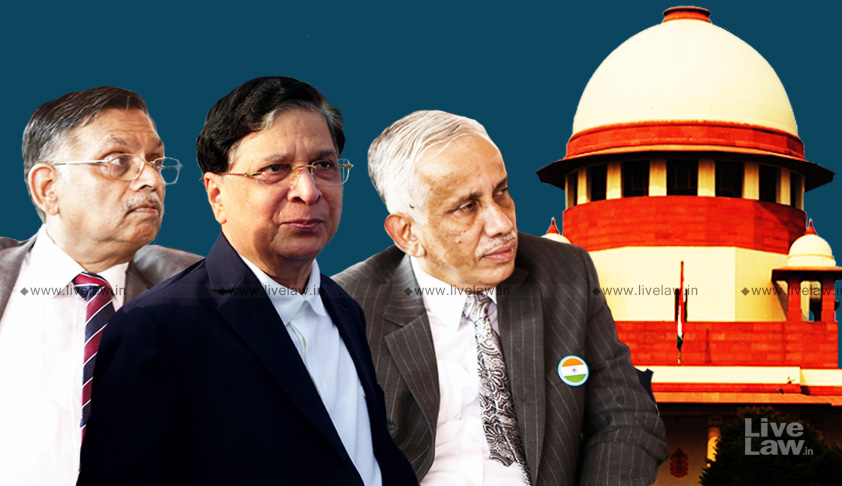Ayodhya : Impact Of Order Refusing Reference To Constitution Bench In The Main Case
M R Shamshad
5 Oct 2018 10:44 AM GMT
A five-judge bench of the Supreme Court in the Ismail Faruqui case of 1994 observed that ‘a mosque is not essential part of the practice of the religion of Islam and namaz by Muslims can be offered anywhere, even in open’ and secondly Place of birth of Lord Ram was has additional protection of law because that place has ‘special significance’. At the instance of the Muslim parties,...
A five-judge bench of the Supreme Court in the Ismail Faruqui case of 1994 observed that ‘a mosque is not essential part of the practice of the religion of Islam and namaz by Muslims can be offered anywhere, even in open’ and secondly Place of birth of Lord Ram was has additional protection of law because that place has ‘special significance’. At the instance of the Muslim parties, the Supreme Court gave a detailed majority judgment rejecting their claim to examine the correctness of these observations and refer it to a larger bench.
By this recent, majority judgement of the Chief Justice of India and Justice Ashok Bhushan, it has been clarified that the observations about ‘essentiality’ of mosque ‘need not be read broadly to hold that mosque can never be an essential part of the practice of religion of Islam’ as the earlier observation was in the context of acquisition of land and further stated that ‘those observations were neither relevant for deciding for suits nor for these appeals’. If the issue was so simple, there could have been clarification that if the observations have affected the High Court judgement, which, in fact it has affected, they would not be relied upon and stands set aside as the Mosque cannot be said to be non-essential for the practice of Namaz. That clarity is missing.
In other parts of the majority judgment, there are two serious observations. One, that the issue of ‘particular significance’ in the Ismail Faruqui case is in the context ‘when acquisition of such place results in extinction of right to practice religion’ because those circumstances would lead to violation of Article 25 of the Constitution. Second, that Place of birth of Lord Ram, as sacred place, ‘has been pleaded by Hindu community’.
With respect to the first issue, the arguments of Dr Rajiv Dhawan, for Muslim parties, was that no concept of particular significance can be brought in with respect to any religion or religious places. If one brings in such distinction, the object of equal treatment with religious places shall be in serious jeopardy. Now, in my reading of the judgement, the court has in a way again said the same thing about the concept of ‘special significance’ that ‘the exception carved out by the Constitution bench is to protect the constitutional right guaranteed under Article 25’. This observation amounts to advancing the issue further in the other direction against which the grievance was raised.
The second aspect, if these observations particular significance has also affected the High Court judgment, which in fact has, then why should this be left to be argued at the time of hearing in appeal, as this judgment does. The whole point is that this question of law be resolved before the parties are called upon to argue on merits of title of land without giving any community any special protection of the constitutional right. Now in the present situation, as the issue has remained open to be argued, would there be another chance to argue the matter for referring the case to larger bench to resolve the very same issue?
In minority judgment, Justice Nazeer has extracted in seventeen pages of his judgment from the High Court judgment to show as to how Justices Sudhir Agarwal and D V Sharma of the High Court have relied upon the propositions of the Ismail Faruqui case while deciding title suit. Then he reached the conclusion that the impugned judgment have been ‘certainly permeated’ and ‘inherently affected by the questionable observations made in Ismail Faruqui’ and it ‘needs to be brought in the line with’ of other pronouncements of larger benches on the issue of religious practice. His view is worth considering that the Ismail Faruqui observations about mosque, without undertaking comprehensive exercise of examining the religious tenets and belief gives ground to refer the case to larger bench to examine four questions of law as he has framed in his judgment. This issue becomes further important when we see suo moto petitions, PILs, which ultimately decided Triple Talaq, was posted before a Constitution bench by two judges without framing questions of law.
Another aspect is that, there is trend of writing long judgments. For speaking judgments, writing reasons is the requirement. However, many judgments, as we see, the reasons are too lengthy rather than in being precise. In the recent majority judgment, a lot of text has been devoted to state as to how, generally, the judgments should be read, interpreted and understood and in particular how the Ismail Faruqui judgment has to be understood. I find a lot of scope in this recent majority judgment to reach a conclusion that the observation about ‘special significance’ given to one religious practice is still alive. There is no clarity that the issue of particular significance shall not be subject matter of final appeal and no party shall make any arguments on this issue. Rather, in clear terms, I find inconsistent observations in the majority judgement with respect to the issue of ‘particular significance’ of religious place. According to majority judgment, that inherently affected portion of the High Court judgment is still open for arguments.
 M R Shamshad is an Advocate-on-Record (Appeared in the Supreme Court for Iqbal Ansari)
M R Shamshad is an Advocate-on-Record (Appeared in the Supreme Court for Iqbal Ansari)[The opinions expressed in this article are the personal opinions of the author. The facts and opinions appearing in the article do not reflect the views of LiveLaw and LiveLaw does not assume any responsibility or liability for the same]


